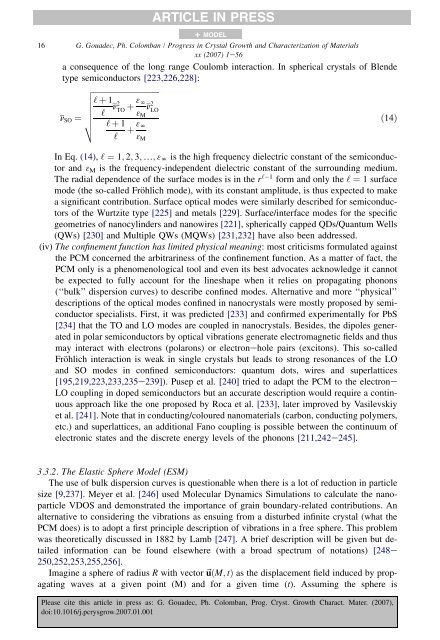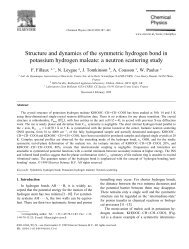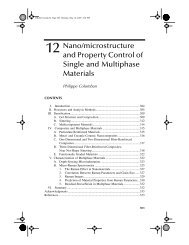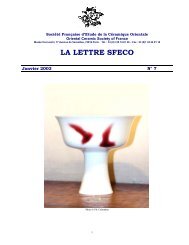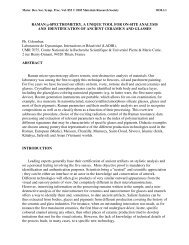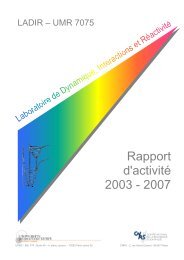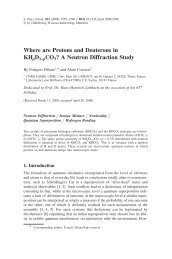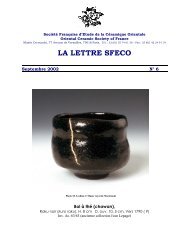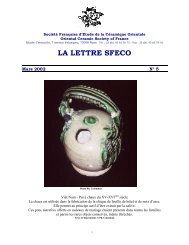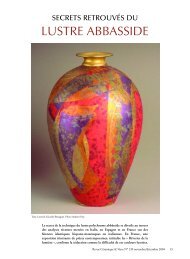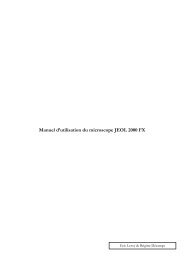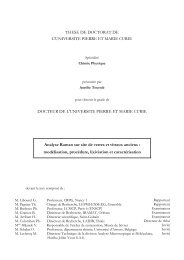Raman Spectroscopy of nanomaterials - institut de chimie et des ...
Raman Spectroscopy of nanomaterials - institut de chimie et des ...
Raman Spectroscopy of nanomaterials - institut de chimie et des ...
You also want an ePaper? Increase the reach of your titles
YUMPU automatically turns print PDFs into web optimized ePapers that Google loves.
ARTICLE IN PRESS+ MODEL16 G. Goua<strong>de</strong>c, Ph. Colomban / Progress in Crystal Growth and Characterization <strong>of</strong> Materialsxx (2007) 1e56a consequence <strong>of</strong> the long range Coulomb interaction. In spherical crystals <strong>of</strong> Blen<strong>de</strong>type semiconductors [223,226,228]:vffiffiffiffiffiffiffiffiffiffiffiffiffiffiffiffiffiffiffiffiffiffiffiffiffiffiffiffiffiffiffiffiffiffi‘ þ 1‘ n2 TO þ 3 Nn 2 LO3n SO ¼ uMt ‘ þ 1þ 3 ð14ÞN‘ 3 MIn Eq. (14), ‘ ¼ 1; 2; 3; .; 3 N is the high frequency dielectric constant <strong>of</strong> the semiconductorand 3 M is the frequency-in<strong>de</strong>pen<strong>de</strong>nt dielectric constant <strong>of</strong> the surrounding medium.The radial <strong>de</strong>pen<strong>de</strong>nce <strong>of</strong> the surface mo<strong>de</strong>s is in the r ‘ 1 form and only the ‘ ¼ 1 surfacemo<strong>de</strong> (the so-called Fröhlich mo<strong>de</strong>), with its constant amplitu<strong>de</strong>, is thus expected to makea significant contribution. Surface optical mo<strong>de</strong>s were similarly <strong>de</strong>scribed for semiconductors<strong>of</strong> the Wurtzite type [225] and m<strong>et</strong>als [229]. Surface/interface mo<strong>de</strong>s for the specificgeom<strong>et</strong>ries <strong>of</strong> nanocylin<strong>de</strong>rs and nanowires [221], spherically capped QDs/Quantum Wells(QWs) [230] and Multiple QWs (MQWs) [231,232] have also been addressed.(iv) The confinement function has limited physical meaning: most criticisms formulated againstthe PCM concerned the arbitrariness <strong>of</strong> the confinement function. As a matter <strong>of</strong> fact, thePCM only is a phenomenological tool and even its best advocates acknowledge it cannotbe expected to fully account for the lineshape when it relies on propagating phonons(‘‘bulk’’ dispersion curves) to <strong>de</strong>scribe confined mo<strong>de</strong>s. Alternative and more ‘‘physical’’<strong>de</strong>scriptions <strong>of</strong> the optical mo<strong>de</strong>s confined in nanocrystals were mostly proposed by semiconductorspecialists. First, it was predicted [233] and confirmed experimentally for PbS[234] that the TO and LO mo<strong>de</strong>s are coupled in nanocrystals. Besi<strong>de</strong>s, the dipoles generatedin polar semiconductors by optical vibrations generate electromagn<strong>et</strong>ic fields and thusmay interact with electrons (polarons) or electronehole pairs (excitons). This so-calledFröhlich interaction is weak in single crystals but leads to strong resonances <strong>of</strong> the LOand SO mo<strong>de</strong>s in confined semiconductors: quantum dots, wires and superlattices[195,219,223,233,235e239]). Pusep <strong>et</strong> al. [240] tried to adapt the PCM to the electroneLO coupling in doped semiconductors but an accurate <strong>de</strong>scription would require a continuousapproach like the one proposed by Roca <strong>et</strong> al. [233], later improved by Vasilevskiy<strong>et</strong> al. [241]. Note that in conducting/coloured <strong>nanomaterials</strong> (carbon, conducting polymers,<strong>et</strong>c.) and superlattices, an additional Fano coupling is possible b<strong>et</strong>ween the continuum <strong>of</strong>electronic states and the discr<strong>et</strong>e energy levels <strong>of</strong> the phonons [211,242e245].3.3.2. The Elastic Sphere Mo<strong>de</strong>l (ESM)The use <strong>of</strong> bulk dispersion curves is questionable when there is a lot <strong>of</strong> reduction in particlesize [9,237]. Meyer <strong>et</strong> al. [246] used Molecular Dynamics Simulations to calculate the nanoparticleVDOS and <strong>de</strong>monstrated the importance <strong>of</strong> grain boundary-related contributions. Analternative to consi<strong>de</strong>ring the vibrations as ensuing from a disturbed infinite crystal (what thePCM does) is to adopt a first principle <strong>de</strong>scription <strong>of</strong> vibrations in a free sphere. This problemwas theor<strong>et</strong>ically discussed in 1882 by Lamb [247]. A brief <strong>de</strong>scription will be given but <strong>de</strong>tailedinformation can be found elsewhere (with a broad spectrum <strong>of</strong> notations) [248e250,252,253,255,256].Imagine a sphere <strong>of</strong> radius R with vector ~uðM; tÞ as the displacement field induced by propagatingwaves at a given point (M) and for a given time (t). Assuming the sphere isPlease cite this article in press as: G. Goua<strong>de</strong>c, Ph. Colomban, Prog. Cryst. Growth Charact. Mater. (2007),doi:10.1016/j.pcrysgrow.2007.01.001


